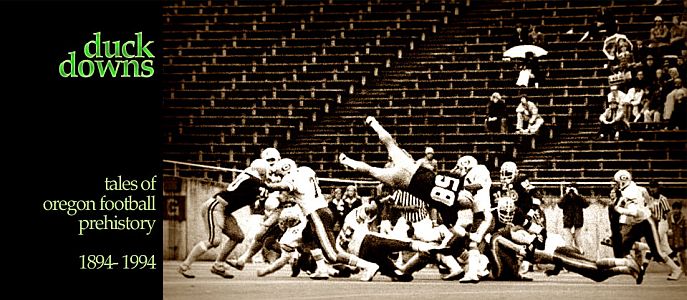Autzen: What Might Have Been
A drive-in football stadium?
 — Eugene Register-Guard, 5 Feb 1961
— Eugene Register-Guard, 5 Feb 1961
Talk about your rough drafts. Autzen could have been the nation’s first, and probably only, football stadium with end-zone, in-game tailgating.
In 1960, then-AD Leo Harris went on a cross-country tour of stadiums with Medford contractor and UO alum Marshall Bessonette. On their return, Bessonette, who designed the stadium for Medford High, prepared a model for a proposed new stadium on a 92-acre tract near the Day Island Landfill, across the Willamette about a mile from the campus.
The model was commissioned by the UO Alumni Association’s Athletic Advisory Committee, which released a proposal report and a 5x3’ mockup of the stadum in February of 1961. The proposed stadium had 40,000 seats – all sideline. 9,000 seats on each side would be in a concrete structure over a filled area surrounding a “bowl”, and 11,000 on either side of the field within the “bowl”. It was thought that Oregon fans were used to covered seating, since the majority of seats at both home stadiums (Hayward in Eugene and Municipal in Portland) were under cover, and an alternate plan was proposed to cover the entire seating area on both sides.
In a novel alternative to end-zone seating, the designers proposed “view” parking, with staggered concentric ramps and spaces striped for 400 cars. The thought was that fans could watch the game from the comfort of their Chevy Impalas, Ford Fairlanes and Dodge Darts.
Some design concepts of the mock-up eventually made it to Autzen. Besides the concrete-over-dirt-bowl engineering, the stadium wouldn’t host a track; seats were to be placed within 20 feet of the sidelines, “bringing the seats closer to the action than most stadiums.” The seats were to be made of wood benches fastened to the concrete base. The field was to be “from 8 to 10 feet below ground level.”
The new stadium would be dedicated to football, but could be used for “possibly other large assemblies like a pageant.”
The drive-in feature didn’t make it past the first proposed design stage, because of “cost considerations.” (Someone probably calculated how many actual ticketed seats could be fit into the space required to maneuver and park 400 cars, or maybe what putting 400 cars in the middle of a stadium might mean in terms of insurance liability, and said “Gee, maybe there IS a reason this hasn’t been done.”) Which is too bad. An Autzen Stadium with 40,000 covered seats holding fans in full-throat delirium, accompanied by a chorus of 400 blaring car horns and flashing lights, might have been … fun. It could have given a new meaning to the term “false start.”
 Autzen Stadium,
Autzen Stadium,  oregon football history in
oregon football history in  general
general 

Reader Comments (1)